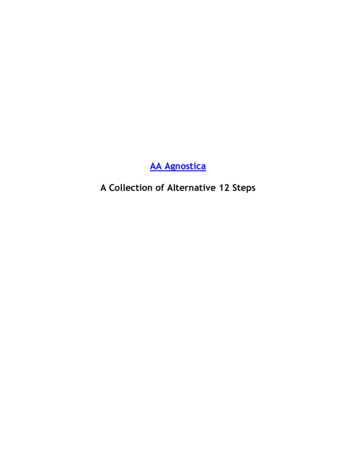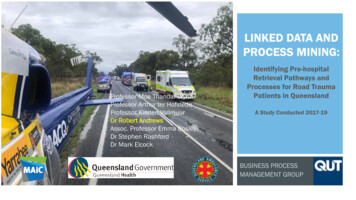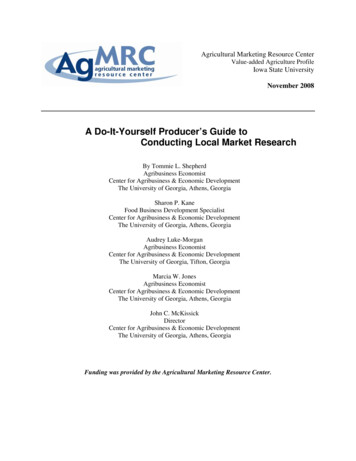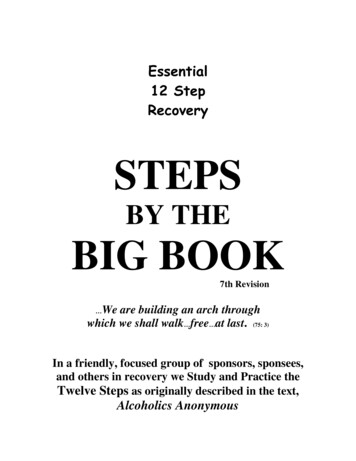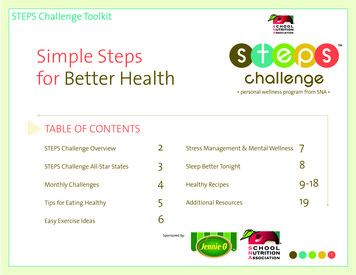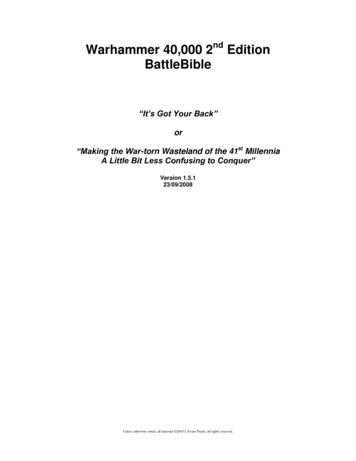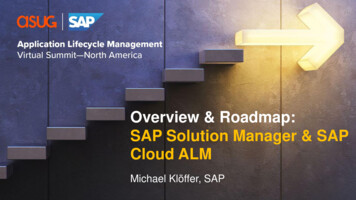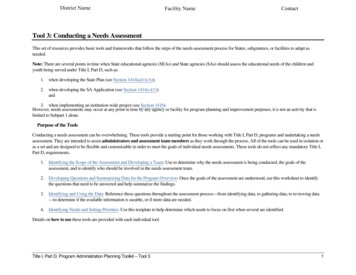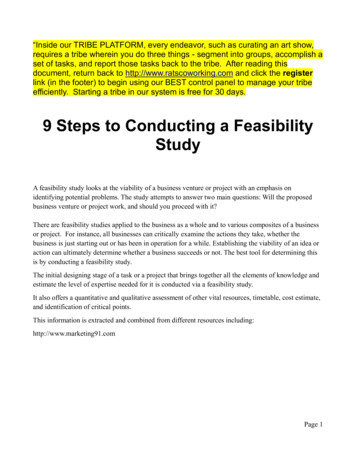
Transcription
“Inside our TRIBE PLATFORM, every endeavor, such as curating an art show,requires a tribe wherein you do three things - segment into groups, accomplish aset of tasks, and report those tasks back to the tribe. After reading thisdocument, return back to http://www.ratscoworking.com and click the registerlink (in the footer) to begin using our BEST control panel to manage your tribeefficiently. Starting a tribe in our system is free for 30 days.9 Steps to Conducting a FeasibilityStudyA feasibility study looks at the viability of a business venture or project with an emphasis onidentifying potential problems. The study attempts to answer two main questions: Will the proposedbusiness venture or project work, and should you proceed with it?There are feasibility studies applied to the business as a whole and to various composites of a businessor project. For instance, all businesses can critically examine the actions they take, whether thebusiness is just starting out or has been in operation for a while. Establishing the viability of an idea oraction can ultimately determine whether a business succeeds or not. The best tool for determining thisis by conducting a feasibility study.The initial designing stage of a task or a project that brings together all the elements of knowledge andestimate the level of expertise needed for it is conducted via a feasibility study.It also offers a quantitative and qualitative assessment of other vital resources, timetable, cost estimate,and identification of critical points.This information is extracted and combined from different resources including:http://www.marketing91.comPage 1
Step 1: Study your Feasibility StudyWhile feasibility studies aretypically conducted by businessorganizations, otherorganizations can naturallybenefit from it as well. Sincethe study aims to discoverwhether an action is viable, itcan help organizations to avoidcostly or operationallyexhausting ventures.Image from www.marketing91.com/feasibility-study/be used?When should a feasibility studyThe study is typically used in situations where an important strategic decision needs to be taken.This can vary and some of the example situations include: Change in business locationPurchase of new equipment or softwareAcquisition of another companyHiring of additional employeesWhy are Feasibility Studies So Important?The information you gather and present in your feasibility study will help you identify all the thingsyou need to make the business work, pinpoint logistical and other business-related problems andsolutions, develop marketing strategies to convince a bank or investor that your business is worthinvesting in, and serve as a solid foundation for developing a plan for startup.Page 2
What are some Types or Forms of a Feasibility Study?#1 Technical feasibilityThe first element deals with technical feasibility of theproposed action plan. If your organization is introducinga new product or a service, the technical feasibilitystudy will determine if it’s a technically viable action.Secondly, the technical feasibility assessment is about the outline design and the ability tohandle the technical expertise of the project. It measures the particular technical solution andthen files its report giving details of: The economic and human factorPossible solutions to the problemsThe specific part of a problem that is being evaluatedBrief description of the problem or its composites for more assessment.Thirdly, this part of the feasibility study should answer the following questions: What is the proposed product or service? Is the product or service already on sale? If not, how far is it from an existingmarketplace and what will the introduction cost? How can you protect the product or service from the competition? What are the strengths of the product or service? What are the main benefits to customers or users?What resources are required for producing or providing it?How capable is the organization to acquire these resources?What are the regulatory standards surrounding the product or service and its use?Remember the above questions can be used when you are introducing a new product orlaunching a business, but also if you are implementing a new product or service within yourorganization. For instance, if you are introducing new software, you must understand thestrengths of it, as well as the resources required for implementing it.Page 3
#2 Legal feasibilityThe feasibility study determines whether theproposed system conflicts with legalrequirements and ethical considerations or not.#3 Time feasibilityA time feasibility study takes into account the periodneeded to complete the project. It is a measure of thereasonability of a project and thus determines whetherthe deadline is desirable or mandatory or not.#4 Resource feasibilityA resource feasibility study measures whether youhave required resources and the facilities to build andcomplete the new project and whether it will interferewith the present business operations.#5 Operational feasibilityThe operational feasibility study determines how theproposed system will solve any problem and takeadvantage of the identified opportunities.Page 4
It puts its focus on how the proposed development fits with the objectives and environment ofthe business regarding existing processes, corporate culture, delivery date, and developmentschedule.#6 Financial feasibilityThe second element focuses on testing the market forthe proposed action or idea. It examines issues likewhether the product or service can be sold atreasonable prices or if there’s a marketplace for it.Market feasibility should answer the following questions: What market segments are you targeting?Why would people buy the product or service?Who are the potential customers and how many of them are there?What are the buying patterns of these potential customers?How will you sell the product or service? Where?Who are your competitors? Including past, current and future competitors.What are the strengths and weaknesses of your competitors?What is your product or service’s competitive edge?The above essentially points out to the importance of conducting market research as part of yourfeasibility study. Market feasibility is an important part of a feasibility study when the plan ofaction deals with issues such as business expansion, new product or service launch, productdevelopment and starting up a business.Page 5
#7 Commercial feasibilityCommercial feasibility is an element of the studyfocused on the probability of commercial success. It’smainly focused on studying the new business or a newproduct or service, and whether your organization cancreate enough profit with it.The questions that require answering as part of the commercial feasibility study include: What are the strengths and weaknesses of your business?What are the potential sales volumes of the product or service?What is the pricing structure you’ll use?What are the sensitivity points for your business in terms of sales?What is the ROI?Furthermore, if you are conducting a feasibility study as part of launching a business orproject or several of their composites, you also need to answer the following questions: How long can your business survive without a sale? How long before you break even with the product or service? How much money is required to start operating? Will your organization require external finance? Is this plan technically feasible? Is this plan legal?Is this plan operationally feasible?Is this plan feasible within a reasonable period of time?Is this plan economically feasible?While the above points are mainly important for new businesses, any organization can benefitfrom thinking about them when launching a new operation.For example, if you are adding a new product line to your business, you should use the abovequestions as a guide to understanding the implications to your other operations and the financialviability of the new product.Page 6
Step 2: Conduct preliminary analysisBegin by outlining your plan. You should focus on anunserved need, a market where the demand is greaterthan the supply, and whether the product or servicehas a distinct advantage. Then you need to determineif the hurdles are too high to clear.A feasibility study can be a time-consuming process and it doesn’t come without its costs. It’stherefore auspicious to start by conducting preliminary analysis. This is essentially a prescreening of the proposed action and it examines whether a proper feasibility assessment isworth the time and money.For example, before you conduct a feasibility study on the viability of acquiring a business, youwant to check quickly the overall attainability of the action. If the acquisition is so risky that itcould bankrupt your business, there’s no reason for conducting a proper feasibility study.Preliminary assessment should consist of the following steps: First, you want to outline the planned idea or action. This means looking at what you arelooking to achieve and why. Second, you should examine the market space and the commercial viability of the action.You want to get an overall feel of what type of customers are you potentially attracting. Third, you should examine the unique characteristics of the idea and whether they arestrength or a weakness. The idea or action might have certain unique characteristics (i.e.location, price, usability) and these might help your organization. Fourth, you need to determine if there are insurmountable risks to the action. It’sessential to outline any risks that could possibly reduce the viability of the action or ideaclose to zero.Keep in mind the above is just to get an overall feel of the idea. You don’t need to conduct fullmarket research at this point, but simply understand whether there’s any kind of space for theaction within the market.If your preliminary analysis doesn’t find any insurmountable obstacles and the commercialviability is possibly there, you can continue with the proper feasibility study.Page 7
Step 3: Outlining the project scope and conducting currentanalysisOnce the groundwork of the previous steps has beenlaid, it’s time to set up the organization and operationsof the planned business venture. This is not asuperficial, broadstroke endeavor.It should be thorough and include start-up costs, fixed investments and operation costs. Thesecosts address things such as equipment, merchandising methods, real estate, personnel, supplyavailability, overhead, etc.Next, you should move on to outlining the project scope by defining the area of study for thefeasibility study. Do you need to look at all five elements of the study, for example?The scope must be detailed and outline the objectives of the feasibility study clearly. It’s a goodidea to examine the above five elements in terms of your action or idea and create an action planfor each section that applies to the project.It’s essential to study the different parts of your business that might be influenced by theproposed action or idea, even when you aren’t proposing something that impacts the wholebusiness directly (i.e. launching a new product, acquiring a business or starting a business).Actions, such as hiring new personnel to a single department, can sometimes have an impact onsectors that might not immediately seem obvious.The key to outlining the scope is about understanding the different participants and end-users ofthe proposed idea or action. For instance, if you are moving the business to new premises, youhave to understand the impact it’ll have on the workforce (change in commute can an impact onemployee morale, etc.) and the customer (will all customers follow your business to a newlocation, etc.).Finally, you also need to analyze the current situation prior to the implementation of the idea oraction. You can do so by describing the weaknesses and strengths of the business. Once you’vedone this, you can study the savings and the operational benefits you are hoping to achieve withthe new proposal.Step 4: Comparing your proposal with existingproducts/servicesPage 8
This step is key to the success of your feasibilitystudy, so make it as thorough as possible. It’s soimportant that if your organization doesn’t have theresources to do a proper one, then it isadvantageous to hire an outside firm to do so.The market research is going to give you the clearest picture of the revenues you canrealistically expect from the project. Some things to consider are the geographic influence onthe market, demographics, analyzing competitors, value of market and what your share will beand if the market it open to expansion (that is, response to your offer).You’ll also need toresearch the current competitive landscape in order to understand whether the proposed idea oraction is viable. Whether you are implementing a new software or equipment or launching yourown new product, you need to compare the proposed product or service with other similar itemson the market.This might mean you need to compare the feasibility of your chosen software (for example,accounting platform) with other products on the market. What are the benefits of your proposedchoice and what are the weaknesses? Are the risks associated with your chosen software smalleror bigger than those of competitive products?The same analysis applies when launching a new product. Part of your feasibility study mustthen focus on understanding what the customers are looking for and whether your proposed ideaanswers these needs. You should also compare the proposed product with the existing productsor services and focus on the advantages, as well as disadvantages, you might have.Step 5: Examining the market conditionsThis step is key to the success of your feasibility study,so make it as thorough as possible. It’s so importantthat if your organization doesn’t have the resources todo a proper one, then it is advantageous to hire anoutside firm to do so.The market research is going to give you the clearest picture of the revenues you canrealistically expect from the project. Some things to consider are the geographic influence onPage 9
the market, demographics, analyzing competitors, value of market and what your share will beand if the market it open to expansion (that is, response to your offer).Remember that focus groups and interviews provide more subjective data than other methods,like surveys, social media listening, and public domain data. Try to gather a mix of subjectiveand objective data when performing your market research.More specifically, here are four specific starting points when it comes to the analyzing market interms of feasibility. Defining the target market.Studying the buying habits of the target market.Understanding the sale and market share outlook of the proposal.Outlining the product awareness required for the use of your product or service.The following are several common methods for conducting market research: Focus groupsSurveysPersonal interviews (customers, experts, etc.)Observation of other organizationsSocial media listening (great for researching marketing methods)Public domain dataThe main goal of this part of the feasibility study is to understand the revenue projection forimplementing the proposed idea or action. You want to have a realistic understanding of thekind of sale numbers you can expect and the scope of the promotional activities you arerequired to undertake.For example, in terms of product or service awareness, you must be able to determine the typeof marketing required for potential customers to understand and be able to use the item.Step 6: Understanding the financial costsThis step requires you to work backwards. Start with what you expectthe income from the project to be and then what investment is neededto achieve that goal. This is the foundation of an income statement.Things to take into account here include what services are requiredand how much they’ll cost, any adjustments to revenues, such asreimbursements, etc.One of the most important steps for concluding a feasibility studyinvolves calculating the financial costs related to the proposal. Nomatter what type of idea or action your organization is considering,the financial cost of it can be the major point in determining itsPage 10
viability.The first rule of any successful business is the need to have income or it goes bust. Therefore, anyaction your organization takes has to examine the impact it’ll have on the income and profit of thebusiness.The financial costs associated with your proposed idea or action will naturally depend on the proposal.But you have to consider the following points in all instances: The resources required to implement the idea or action. The source for these resources: internal or external financing. The realistic benefits of the idea or action, whether it’s sales figures, boost in productivity, or acut in operational costs. The break-even schedule for the proposal. This refers to the time it takes to a point when theprofits from the idea or action equal the costs associated with it. The financial risks associated with the idea or action. This can refer to risky market conditions,the probability of requiring more resources and so on. The financial cost of failure. You also need to calculate the financial cost of the worst-casescenario. This can determine whether your business has the means of embarking on this newventure or not.The likelihood of having to use estimates in the above calculations is relatively high. It’s important toconduct proper research and to be as realistic with your figures as possible. After all, positive surprises(for example, exceeding sales figures) are not difficult to manage, unlike overly positive calculationsthat turn out wrong.Step 7: Prepare an Opening Day Balance SheetThis includes an estimate of the assets and liabilities,one that should be as accurate as possible. To do this,create a list that includes item, source, cost andavailable financing.Liabilities to consider are such things as leasing or purchasing of land, buildings and equipment,financing for assets and accounts receivables.Step 8: Reviewing and analyzing dataPage 11
Finally, you need to review your feasibility studycarefully and examine the findings with time. A goodrule of thumb is to simply take a step back and reflecton the research before jumping into conclusions.After your study, look around and consider the following questions: Are there any risks you weren’t aware of previously?Have the market conditions changed?Has the competition changed?Is your business situation still the same, in terms of operations and economic situation?If the conditions have changed, you can review these parts of the feasibility study. Once you’vereviewed your results, you can go ahead with the final decision. The feasibility study shouldprovide you the answer of either moving ahead with the proposed idea or action, or scrappingthe idea and looking for something different.Step 9: Make a Go/No-Go DecisionYou’re now at the point to make a decision aboutwhether the project is feasible or not. That soundssimple, but all the previous steps we’re leading to thisdecision-making moment.A couple of other things to consider before making that binary choice is whether thecommitment is worth the time, effort and money and is it aligned with the organization’sstrategic goals and long-term aspirations.Page 12
9 Steps to Conducting a Feasibility Study . A feasibility study looks at the viability of a business venture or project with an emphasis on identifying potential problems. The study attempts to answer two main questions: Will the proposed . The scope must be detailed and outline the objectives of the feasibility study clearly. It's a good

